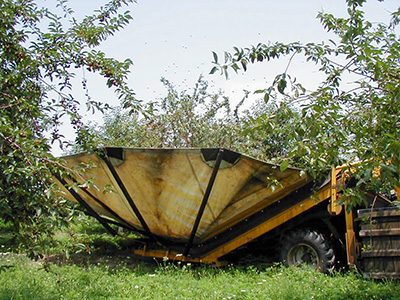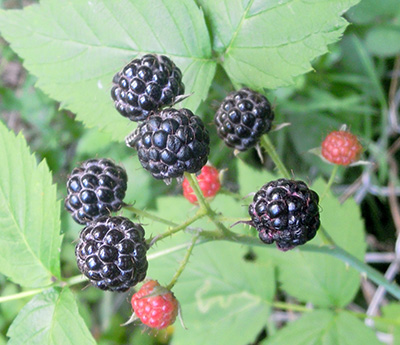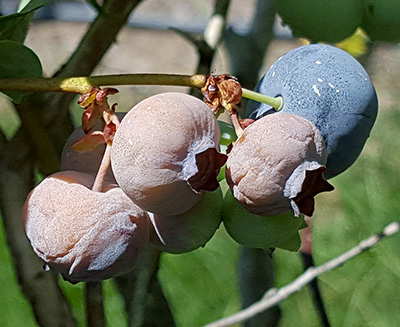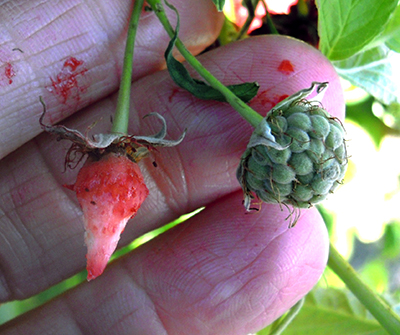Southwest Michigan fruit regional report – July 5, 2016
Tart cherry harvest is in full swing in southwest Michigan.

Weather
Last week was very pleasant. High temperatures were in the 70s. Overnight lows were in the 40s. Showers moved across the area on Friday morning, July 1. These showers were widespread but spotty and dropped little rain in most areas. Rainfall totals for the week were about a third of an inch. Rainfall totals for the season vary from 7 to 15 inches with most Michigan State University Enviro-weather stations receiving about 9 inches of rain since April 1.
Most soils are drying out and growers should be irrigating. Some field crops are beginning to show signs of drought stress. Our daily heat accumulations were less than last week’s with about 23 growing degree-days (GDD) base 42, 20 GDD base 45 and 15 GDD base 50. The coming week will be warmer. Temperatures will be more seasonal. Highs will be in the 80s with lows in the 60s. There is a chance of showers or thunderstorms on Wednesday and Thursday, June 6-7.
Southwest Michigan GDD summary, Jan. 1 through July 3, 2016 |
|||
|---|---|---|---|
|
Station |
GDD 42 F |
GDD 45 F |
GDD 50 F |
|
Benton Harbor (SWMRC) |
1,958 |
1,667 |
1,242 |
|
Lawton (Lawton) |
1,963 |
166 |
1,234 |
|
Fennville (TNRC) |
1,675 |
1,404 |
1,010 |
|
Average for the region |
1,816 |
1,532 |
1,123 |
|
Accumulation last week |
160 |
139 |
105 |
Tree fruit
Young orchards in sandy sites are showing signs of drought stress. Insects were active last week. Trap catch numbers for oriental fruit moth are up sharply, indicating the beginning of the second flight of this pest. Codling moth trap catch numbers are still high in some orchards. Obliquebanded leafroller trap catch numbers are still high. San Jose scale crawlers have settled and are producing their waxy scale, reducing insecticide effectiveness. Trevor Nichols Research Center is catching lesser peachtree borers and greater peachtree borers. Late June to early July or post-harvest are the times for trunk applications to control borers – check the pesticide label for pre-harvest interval restrictions. Scout fruit plantings close to woods, gorges and riparian areas periodically for brown marmorated stink bug infestations.
Apricot harvest is beginning with color picking of early varieties.
Early peaches are coloring, signaling the need to step up brown rot control programs. First harvest of earliest varieties is starting in sandy sites. The crop looks good. Oriental fruit moth numbers are up, indicating the start of the second generation flight. Flagging of terminal growth by oriental fruit moth larvae is common in orchards with weak control programs. Bacterial spot symptoms continue to appear on leaves and fruit of susceptible varieties. The wine-red leaf symptoms of X-disease have shown up in local peach orchards. This generally means that X-disease-infected sweet, tart or choke cherry trees are in the vicinity and need to be removed to help slow disease spread.
Sweet cherry harvest is underway. Birds eating the fruit are a problem. Sweet cherries are especially susceptible to brown rot as they ripen. Growers should use materials that protect against cherry leaf spot and brown rot.
Tart cherry harvest is underway. The crop is variable. Some orchards are not being harvested due to the light crop. Some orchards developed a lot of yellow leaves, but examination of the leaves determined that it was not cherry leaf spot. The cause was probably bacterial canker. Growers continue applying protectant fungicides for cherry leaf spot.
Cherry fruit flies and spotted wing Drosophila have been trapped in low numbers in the region, but catches are expected to climb. Trapping for these two pests in individual orchards is recommended to guide spray decisions. Some growers have applied insecticides for obliquebanded leaf roller larvae. Although feeding on foliage and not fruit, they are showing up in cherry tanks. Because the larvae can be very small, a hand lens is needed to see the straw-colored to dark brown head capsules and legs of obliquebanded leafroller larvae – characteristics that cherry fruit fly and spotted wing Drosophila larvae do not have.

Tart cherries are harvested by shaking the tree and catching the cherries in a frame then cooling them in cold water. Photo: Mark Longstroth, MSU Extension.
Plums’ vulnerability to new black knot infections declines as terminal growth stops. Active black knot growths from last year’s infection are actively expanding. Japanese plums are over an inch in diameter, depending on the variety. European plums are 20 millimeters in diameter. Bacterial spot symptoms can be found on more susceptible varieties. As fruit start to color, brown rot spray programs should be intensified.
Apple fruit are 2 inches in diameter. Growers have been applying summer NAA programs to encourage return bloom next year. Fire blight shoot blight symptoms are scarce and the dry weather has limited spread. Trauma blight symptoms following hail have appeared. Growers should scout their orchards for apple scab lesions to see if they need to continue their scab program.
Fruit entry of codling moth or oriental fruit moth has been noted in several area orchards. Codling moth trap catch number numbers are still high. We are past peak egg hatch. Growers should use insecticides aimed at larvae. We are catching good numbers of obliquebanded leafroller and young larvae of this generation are feeding on foliage.
Sooty blotch and flyspeck diseases require about 220 hours of leaf wetness starting 10 days past petal fall to begin infection. Fungicide programs for these diseases should begin soon as we currently have about 213 hours of leaf wetness since petal fall. A general rule of thumb is reapplication of fungicides for these diseases after an additional 220 hours of leaf wetness, or 2 inches of rain has occurred following application.
Pear fruit are 1.5 inches in diameter. Removing succulent water sprouts from the inside of the tree helps to reduce sites for pear psylla population growth. Pear scab symptoms can be found on the leaves and fruit of unsprayed trees. Sticky leaves due to pear psylla honeydew can be found in some orchards.
Small fruit
Japanese beetles are beginning to emerge and numbers should increase after rains in July. A few spotted wing Drosophila (SWD) are being trapped in some traps in southwest Michigan. Wild berries such as bush honeysuckle, mulberries, saskatoons and black raspberries are ripening. Many wild fruit serve as hosts to SWD. Early ripening fruit help to build SWD populations. We will soon see the first surge in SWD numbers as flies emerge from these fruits.

Wild black raspberries are an excellent host of spotted wing Drosophila. Photo: Mark Longstroth, MSU Extension.
Grapes are beginning to size. The vulnerable window for control of black rot, powdery mildew, downy mildew and Phomopsis is ending in juice grapes, but continues for several more weeks in wine grapes. Relatively dry weather with few infection periods since May has kept disease pressure down thus far. Scout now for developing downy mildew and powdery mildew infections in clusters and on leaves.
The second generation flight of grape berry moth is occurring. The egglaying period began June 30 in Benton Harbor, Michigan, July 3 in Berrien Springs, Michigan, and July 4 in Lawton, Michigan. Growers are applying insecticides to control this pest now. Also, continue scouting for Japanese beetles and leafhoppers on foliage.
Blueberry harvest has started with Duke and other early varieties. We are still catching fruitworm moths in some fields and are now catching blueberry maggot. Blueberry maggot numbers will rise after rains or irrigations. Blueberry maggot should not be a problem in fields that are being sprayed for SWD. A few SDW are being trapped in the region, but this will change. We expect a surge in SWD numbers soon as adults emerge from ripening wild fruit.
Mummy berry fruit rot symptoms are appearing. It is too late for any mummy berry treatment. The dry weather has kept diseases down, but the need to irrigate means growers will create their own infection periods in irrigated fields. In the green fruit stage, fungicides work well preventing anthracnose fruit rot infections if they are applied soon after infection. As fruit begins to ripen, the back-action is lost. Systemic fungicides should be applied before irrigation to protect against fruit rot rather than after to try and stop the infection of ripe fruit. Use the Enviro-weather anthracnose model.
Shoot collapse from Phomopsis stem canker is becoming easier to find. Growers should be irrigating to maintain fruit growth. Growers should pay close attention to soil moisture. Some growers have complained of small fruit on canes with a heavy fruit set and few leaves.

Fruit infected by mummy berry turns brown, dries up and falls off the bush as the fruit begins to ripen. Photo: Mark Longstroth, MSU Extension.
Strawberry fields are being renovated across southwest Michigan. For more information on strawberry renovation, see the MSU Extension articles “Time to renovate strawberries” for cultural considerations, and “Strawberry renovation is due soon” for herbicide choices. Growers with day-neutral strawberries should consider monitoring for SWD.
Bramble harvest is underway with black raspberries (black caps) and early summer red raspberries being harvested. Soils are dry and growers should be irrigating. Raspberries and black berries are shallow rooted and benefit from irrigation under dry conditions. The ripening fruit is attractive to SWD. Growers should have traps on their farms. Some growers are picking every two days to avoid SWD. Raspberry cane borer will be attacking primocanes.

A pink raspberry receptacle is a sign of spotted wing Drosophila (SWD). The receptacle should be white when picking raspberries. SWD larvae feeding in the fruit cause it to leak and strain the receptacle pink. Photo: Diane Brown, MSU Extension.
Upcoming meetings
Tour and discuss organic and conventional fruit production under high tunnels at the 2016 High Tunnel Fruit Production Tour, Tuesday, July 5, from 6:30-8 p.m. at the Horticulture Teaching and Research Center, 3291 College Road, Holt, MI 48842.
The Michigan Blueberry Pollination Field Day will be from 5:30 to 8 p.m. on July 12, 2016, near Pullman, Michigan, in Allegan County.
The annual Viticulture Field Day will be held July 27 at the Southwest Michigan Research and Extension Center, 1791 Hillandale Road, Benton Harbor, MI 49022.
See also:
- Bird management options for fruit growers
- Management of bacterial spot on peaches and nectarines
- Timing trunk sprays for the borer complex in cherries
- Summer leafroller control
- Control of pre- and post-harvest fruit rots in blueberries
- Use anthracnose fruit rot prediction model to assess risk of infection.
- Blueberry fruit rot identification guide (E2847)
- Strawberry renovation is due soon
- Controlling raspberry cane borer



 Print
Print Email
Email



